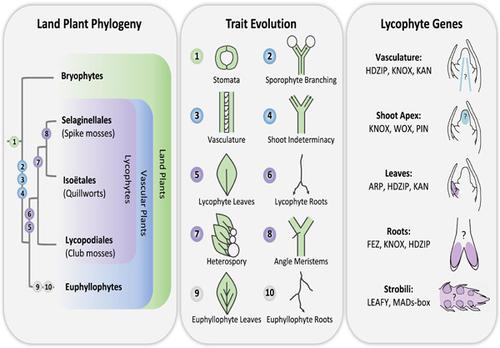当前位置:
X-MOL 学术
›
Evol. Dev.
›
论文详情
Our official English website, www.x-mol.net, welcomes your
feedback! (Note: you will need to create a separate account there.)
What can lycophytes teach us about plant evolution and development? Modern perspectives on an ancient lineage
Evolution and Development ( IF 2.6 ) Pub Date : 2020-09-09 , DOI: 10.1111/ede.12350 Victoria Spencer 1 , Zoe Nemec Venza 1 , Cecily Jill Harrison 1
Evolution and Development ( IF 2.6 ) Pub Date : 2020-09-09 , DOI: 10.1111/ede.12350 Victoria Spencer 1 , Zoe Nemec Venza 1 , Cecily Jill Harrison 1
Affiliation

|
All Evo‐Devo studies rely on representative sampling across the tree of interest to elucidate evolutionary trajectories through time. In land plants, genetic resources are well established in model species representing lineages including bryophytes (mosses, liverworts, and hornworts), monilophytes (ferns and allies), and seed plants (gymnosperms and flowering plants), but few resources are available for lycophytes (club mosses, spike mosses, and quillworts). Living lycophytes are a sister group to the euphyllophytes (the fern and seed plant clade), and have retained several ancestral morphological traits despite divergence from a common ancestor of vascular plants around 420 million years ago. This sister relationship offers a unique opportunity to study the conservation of traits such as sporophyte branching, vasculature, and indeterminacy, as well as the convergent evolution of traits such as leaves and roots which have evolved independently in each vascular plant lineage. To elucidate the evolution of vascular development and leaf formation, molecular studies using RNA Seq, quantitative reverse transcription polymerase chain reaction, in situ hybridisation and phylogenetics have revealed the diversification and expression patterns of KNOX, ARP, HD‐ZIP, KANADI, and WOX gene families in lycophytes. However, the molecular basis of further trait evolution is not known. Here we describe morphological traits of living lycophytes and their extinct relatives, consider the molecular underpinnings of trait evolution and discuss future research required in lycophytes to understand the key evolutionary innovations enabling the growth and development of all vascular plants.
中文翻译:

关于植物进化和发育,石松植物能教给我们什么?古代血统的现代观点
所有 Evo-Devo 研究都依赖于感兴趣的树上的代表性抽样来阐明随时间推移的进化轨迹。在陆地植物中,遗传资源在代表谱系的模式物种中得到了很好的建立,包括苔藓植物(苔藓、地钱和金缕梅)、单叶植物(蕨类植物和同属植物)和种子植物(裸子植物和开花植物),但可用于石松植物的资源很少。棒状苔藓、穗状苔藓和鹅毛笔)。活的石松植物是真叶植物(蕨类植物和种子植物进化枝)的姐妹群,尽管与大约 4.2 亿年前维管植物的共同祖先不同,但仍保留了几种祖先的形态特征。这种姐妹关系提供了一个独特的机会来研究孢子体分枝、脉管系统和不确定性等性状的保护,以及在每个维管植物谱系中独立进化的叶和根等性状的趋同进化。为了阐明血管发育和叶片形成的进化,使用 RNA Seq、定量逆转录聚合酶链反应、原位杂交和系统发育的分子研究揭示了 KNOX、ARP、HD-ZIP、KANADI 和 WOX 基因的多样化和表达模式石松属的家庭。然而,进一步的性状进化的分子基础尚不清楚。在这里,我们描述了活石松植物及其已灭绝亲属的形态特征,考虑了性状进化的分子基础,并讨论了石松植物所需的未来研究,以了解促进所有维管植物生长和发育的关键进化创新。
更新日期:2020-09-09
中文翻译:

关于植物进化和发育,石松植物能教给我们什么?古代血统的现代观点
所有 Evo-Devo 研究都依赖于感兴趣的树上的代表性抽样来阐明随时间推移的进化轨迹。在陆地植物中,遗传资源在代表谱系的模式物种中得到了很好的建立,包括苔藓植物(苔藓、地钱和金缕梅)、单叶植物(蕨类植物和同属植物)和种子植物(裸子植物和开花植物),但可用于石松植物的资源很少。棒状苔藓、穗状苔藓和鹅毛笔)。活的石松植物是真叶植物(蕨类植物和种子植物进化枝)的姐妹群,尽管与大约 4.2 亿年前维管植物的共同祖先不同,但仍保留了几种祖先的形态特征。这种姐妹关系提供了一个独特的机会来研究孢子体分枝、脉管系统和不确定性等性状的保护,以及在每个维管植物谱系中独立进化的叶和根等性状的趋同进化。为了阐明血管发育和叶片形成的进化,使用 RNA Seq、定量逆转录聚合酶链反应、原位杂交和系统发育的分子研究揭示了 KNOX、ARP、HD-ZIP、KANADI 和 WOX 基因的多样化和表达模式石松属的家庭。然而,进一步的性状进化的分子基础尚不清楚。在这里,我们描述了活石松植物及其已灭绝亲属的形态特征,考虑了性状进化的分子基础,并讨论了石松植物所需的未来研究,以了解促进所有维管植物生长和发育的关键进化创新。











































 京公网安备 11010802027423号
京公网安备 11010802027423号